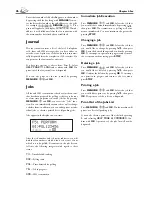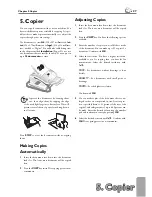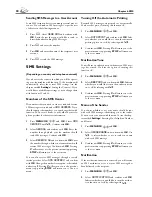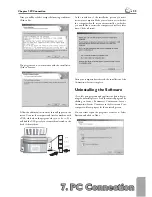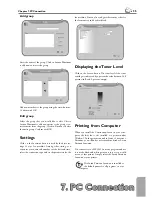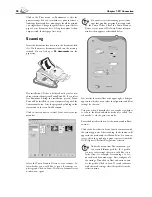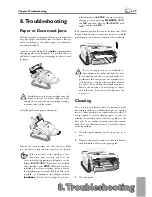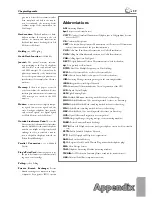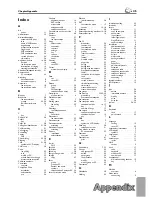
Appendix
Appendix
39
Chapter Appendix
grey tones. After the fax transmission has
been completed and before the connec-
tion is terminated, the receiving device
confi rms receipt of the transmission (see
Fax Groups).
Hard modem:
Th
e hard modem is a fi xed,
built-in modem. In contrast to the soft
modem, its features and functions are
fi xed and thus cannot be changed (see Soft
Modem, see Modem).
Holding:
see Call Toggling
Hook-Flash Function:
see Flash Key
Journal:
Th
e journal contains informa-
tion pertaining to the last 30 telephone
calls as well as to sent and received faxes
and SMS messages. Th
e journal can be
printed out manually or the machine can
be set to dispense automatic print-outs at
specifi c times (for example after 30 trans-
missions).
Memory:
If there is no paper or toner in
your fax machine, the machine will store
incoming fax transmissions in its memory.
SMS messages are stored in the SMS
memory.
Modem:
A modem converts digital compu-
ter signals into acoustic signals and vice
versa. Analogue telephone lines transfer
only acoustic signals, not digital signals
(see Hard Modem, see Soft Modem).
Outside Line Access Code:
Th
e outside
line access code is the number or letter that
must be dialled before the actual telephone
number on a telephone of a private branch
exchange in order to establish a connec-
tion to the public telephone network (see
Private Branch Exchange).
Parallel Connection:
see Additional
Devices
Plug’n’Print Card:
Smart card used to set
the toner level memory to full after install-
ing a new toner cartridge.
Polling:
see Fax Polling
Private Branch Exchange:
Private
branch exchanges are common in larger
companies. Even private ISDN systems
Abbreviations
AM:
Answering Machine
bps:
Bits per second (transfer rate)
CCITT:
Comite Consultatif International Telephonique et Telegraphique (forerun-
ners of the ITU)
CE:
Conformité Européenne
CEPT:
Conference Européenne des Administrations des Postes et des Télécommuni-
cations (interconnection of the post administrations)
CLIP:
Caller Line Identifi cation Presentation (see Caller Identifi cation)
CLIR:
Calling Line Identifi cation Restriction (see Caller Identifi cation)
CNG:
Calling Signal (see Fax Signal)
DECT:
Digital Enhanced Cordless Telecommunication (cordless handset)
dpi
: Dots per inch (see Resolution)
DTMF:
Dual Tone Multiple Frequency (see Tone Dialling)
ECM:
Error Correction Mode (see Error Correction Mode)
GAP:
Generic Access Profi le (radio protocol for cordless handsets)
IGM:
Incoming Message (incoming message on the answering machine)
ISDN:
Integrated Services Digital Network
ITU:
International Telecommunications Union (organisation of the UN)
LCD:
Liquid Crystal Display
LED:
Light Emitting Diode
MH:
Modifi ed Huff mann (encoding method for faxes, see Encoding)
MHC:
Modifi ed Huff mann Code (encoding method for faxes, see Encoding)
MMR:
Modifi ed Modifi ed Read (encoding method for faxes, see Encoding)
MR:
Modifi ed Read (encoding method for faxes, see Encoding)
MRC:
Modifi ed Read Code (encoding method for faxes, see Encoding)
OCR:
Optical Character Recognition (text recognition)
OGM:
Outgoing Message (outgoing message of the answering machine)
PABX:
Private Automatic Branch Exchange
POTS:
Plain Old Telephone Service (analogue telephone service with low transfer
rate)
PSTN:
Public Switched Telephone Network
PTT:
Postal, Telegraph and Telephone (organisation)
RAM:
Random Access Memory
RJ-11:
Registered Jack 11 (auch Western Plug, standardised telephone plug)
SMS:
Short Message Service
TAM:
Telephone Answering Machine (answering machine)
TWAIN:
Tool Without An Interesting Name (standard for scanner drivers)
USB:
Universal Serial Bus (computer connection)
Summary of Contents for MF 3265
Page 1: ...User Manual FAX 3245 MF 3265...
Page 44: ...44 ChapterAppendix...


